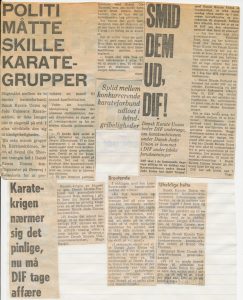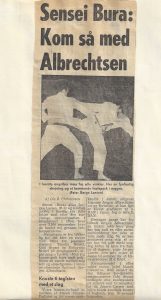The association game
The colorful Danish karate history, on the foundation of private Judo and Jujutsu businesses
In the early 1960s, Kringelbach's Judo and Jiujitsu institute was located on Vor Frue's place. One of Kringelbach's instructors was Jørgen Buller Larsen, who was a 1st dan in Judo and Jujutsu. A great many karate books had begun to be published which were diligently read and the interest was quite high.
At the beginning of 1961, a Japanese Goju-ryu Karate-do instructor Okamoto was hired at Kringelbach. This meant that almost all of Kringelbach's instructors also started training Goju-ryu Karate-do, including Jørgen Buller Larsen (from 1981 Bura), who quickly became 1st dan, Goju-ryu Karate-do.
In 1963, the Japanese instructor Okamoto was helped to establish Goju-ryu Karate-do with his own association by Jørgen Albrechsen and they broke with Kringelbach. But Okamoto chose shortly after to return to Japan. Jørgen Albrechsen chose to make contact with Kyokushinkai in 1967 and Jørgen Buller Larsen with JKA Shotokan, who sent Kobayashi Sensei to Denmark in 1963 for a longer period.
It was the starting point for Japanese karate-do's establishment and development in Denmark within just a few years.
In Denmark and Europe, Japanese martial arts had a very good reputation as a gentleman's sport until the decade of the 70s. Then came the era and the decade with first the deadly avenger Bruce Lee and then all the Ninja movies of the 80s, which supported the previously mentioned worldwide zeitgeist and Japanese imports of the shadow side relationships (Yakuza methods).
The businessman Jørgen Albrechtsen quickly smelled gold and was an eminent leader for capturing the spirit of the times and what people demanded. Well supported by own perception of; "We don't find ourselves in anything - No one above and no one next to us - WE are the real and only karate!".
Sokaiya - intimidation through name-calling, slander and trash-talk quickly became commonplace. In addition, he had few obstacles and skills in aggressive marketing of the angry zeitgeist, with back-up from Kyokushinkai founder Oyama Sensei, Japanese methods inspired by Yakuza methods.
It is said that Oyama Sensei demonstrated total obedience and loyalty by asking black belts to jump out of the second floor window of the Honbu-dojo, Ikebukuro, Tokyo when he asked them to - and they did so with severe injuries.
It was definitely not Danish or Scandinavian culture, so in the first years, the aggressive marketing methods were not really met with as much opposition.
It wasn't because JKA Shotokan didn't also have the perception that they were also the real karate-do, but their behavior was more inspired by the harsh Samurai warrior culture – There can only be one. Both karate-do organizations were strictly hierarchical, and today one would probably think dictatorially structured with a very strict discipline.
At some point, the competitors had had enough. It is said that JKA Shotokan and Gensei-ryu called on Kyokushinkai several times for a decisive battle about who was the best, but it was initially internal and never came to fruition. But that was about to change!
On Amager were the main schools for JKA Shotokan and Gensei-ryu Karate-do's, and they became increasingly tired of the aggressive Sokaiya marketing from Kyokushinkai Karate-do.
Until 1974, JKA Shotokan had not really been able to match Kyokushinkai in aggressive and successful marketing following the zeitgeist. But that changed because of the friendship and collaboration between Jørgen Buller Larsen and Sven Ole Thorsen with Sporting Health Club. Sven Ole Thorsen was a world-class powerlifter, bodybuilder and lifelong friend of Arnold Schwarznegger, who later got him many Hollywood film roles.
When Sven Ole Thorsen became friends with Jørgen Bura Larsen, a lot happened on the marketing front, not least because of his friendship with Solo ballerina Kirsten Simone, who at the time was dating the Danish Minister of Culture, Niels Matthiasen.
From left to right Arnold SSchwarzenegger, Clint Eastwood and Sven Ole Thorsen.
At the same time, the world champion Masahiko Tanaka from JKA Shotokan was employed as Danish national coach from 1975-1978, and with the marketing from Sven Ole Thorsen, JKA Shotokan flourished in Denmark, soon to be one of the best karate nations in the world, and attracted many Japanese instructors from the JKA main school in Yotsuya, Tokyo.
Jørgen Albrechtsen tried to match this with a Kyokushin world champion, Sato, who, however, was sent home very quickly due to bad behavior and behavior, and with close Yakuza connections, some journalists had dusted off. However, the explanation from the official Kyokushinkai side was unhealthy womanizing and high phone bills. But in the 70s, Denmark was particularly known for the release of porn and make love not war, which attracted a completely different tourism than Nordic Cuisine in the last decade. It was widely known during that time period that both the Japanese, Korean, Chinese and European top instructors were highly sought after as trophy change by the opposite sex, and it was not only in Denmark.
In 1976, Sven Ole Thorsen was graduated 1st dan, JKA Shotokan by Tanaka Sensei, and later also became Danish champion. It is also said that he had a side job, as a debt collector along with his strength training and bodybuilder friends, and large amounts of anabolic steroids and other performance-enhancing drugs were used during the period.
By the way, it was quite common in all sports - it was before the doping control.
Sven Ole Thorsen and JKA's management were eventually very tired of trash talk from Kyokushinkai's side and their failure to accept the final decision about who is the best, so Sven Ole Thorsen took matters into his own hands and used Kyokushinkai's own methods against them self. Sven Ole Thorsen at 143 kg, 1.93 m and 7-15 JKA members trooped up during a training session at Ørnevej, which was Kyokushinkai's main school and the world's largest karate school, and performed Sokaiya.
It is said that the team consisted of more than 100 Kyokushinkai members, but no one dared to do anything. Nor did Jørgen Albrechtsen, who ran into his office and locked the door. He tried several times to call the police, who didn't show much will to come forward, as they apparently also had a problem with the aggressive marketing over the years of Kyokushinkai and the many problems it had caused.
The police took their time, and when they finally arrived, Sven Ole Thorsen greeted his father's old colleague who was the police leader of the team, after which nothing more happened in the case.
Jørgen Bura Larsen, Sven Ole Thorsen and the JKA mocked the Kyokushinkai for not defending their own headquarters, which was occupied by just a handful of JKA Shotokan people. Jørgen Albrechtsen from Kyokushinkai defended himself by saying that he was a gentleman and it was nonsense to have to fight some illegally invading competitors. It was word against word, but the fact is that it actually happened when it made the headlines in all the country's newspapers.
So did the official challenge from Gensei-ryu Karate-do's chief instructor, Klaus Sivertsen, to Jørgen Albrechtsen and other Kyokushinkai top people to fight the final battle, as Klaus Sivertsen, like many others, had reached the limit of Kyokushinkai's Sokaiya and trash talk. Jørgen Bura Larsen from JKA Shotokan did the same many times.
It didn't really come to fruition either, but it is said that the respect and management foundation under Oyama Sensei's Danish chief instructor, Jørgen Albrechtsen, 5th dan Kyokushinkai began to be challenged.
It wasn't because he was the only colorful Kyokushinkai personality because there were several, but he was challenged and there were various rebellions and breaks. The most successful Kyokushinkai fighter of the time period also made national headlines when he robbed a bank and shot at the police while fleeing. He went to prison and is now fully rehabilitated. There were several others who also reached the newspapers.
JKA Shotokan was also colourful, and there were big eyes when one of the leading JKA fighters was escorted by the police, as he had an exit permit from prison so that he could fight for the Danish championship.
The mid-80s to the early 90s were very successful on a global scale for Danish karate, as one of the best nations in the world led by a very competent DIF karate association - the Danish Karate Association which was now recognized as an independent specialist association, instead of being subject to the Danish Judo and Jujutsu Federation.
This is largely due to Jørgen Bura's uncompromising work, with back-up from Jess Petersen from Gensei-ryu who, together with his brother Steen, had established the international karate event Genshikan Cup, Henrik Larsen from Goju-ryu, but also other Shotokan leaders, who after Nakayama Sensei's death in 1987, was split into 5-10 different Shotokan federations.
Therefore there was also a JKA break and rebellion in Denmark, both politically, but also against Bura Sensei, where there were several who thought they could do it better and more modern. The later Danish karate history tells the facts.












